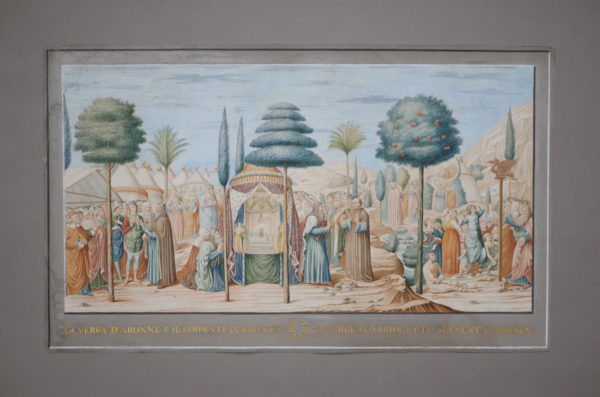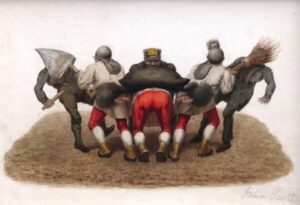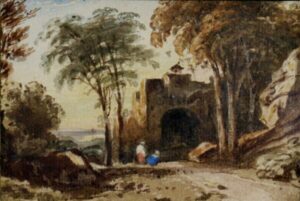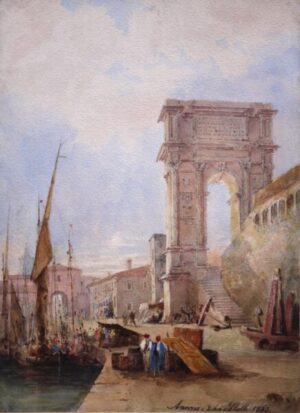Description
Conte Carlo Lasinio (1759-1838) after Benozzo Gozzoli (1420-1497)
The book from which this engraving was published is important for bringing into focus the mutual interests of the early Pre-Raphaelite circle, and especially DGR, Millais, and Hunt. It contains Carlo Lasinio’s engravings from fifteenth-century paintings attributed to Giotto, Memmi, Gozzoli, and other early Italian masters. The spare style and linear simplicity appealed to DGR and his friends as marks of a pictorial attitude wholly unlike the reigning academic canons, in particular what they called the slosh they saw promoted by Sir Joshua Reynolds..
In his Memoir of his brother’s life, William Michael Rossetti quotes Holman Hunt as follows: “The companionship of Rossetti and myself [in 1848] soon brought about a meeting with Millais, at whose house one night we found a book of engravings of the frescoes in the Campo Santo at Pisa.”. This book proved the catalyst for the founding of The Pre-Raphaelite Brotherhood. As WMR went on to point out, the engravings were important to the three young men for giving “some idea of the motives, feeling, and treatment, of the paintings of Gozzoli, and of those ascribed to Orcagna and other medieval masters. It seems that Rossetti was not quite prepared beforehand to believe in these very olden painters, and Brown specially cautioned him not to undervalue them. I well recollect the enthusiasm with which, subsequently to seeing the engravings, Dante spoke to me on the subject”.
DGR himself later acquired a copy of the book in the 1828 third printing of the first edition. It had been quite a successful work, in fact. Lasinio brought out a prospectus for its publication in 1806 and an initial printing in 1812. Another printing appeared in 1822, and a second edition appeared in 1832-1833 “disegnate ed incise da Giuseppe Rossi e dal G. Paolo Lasinio” (Lasinio’s son). It is not clear whether DGR knew the second edition’s (re-engraved) plates.
Brand
Lasinio, Conte Carlo (1759-1838)
Lasinio was born at Treviso, but worked chiefly at Florence. He started as a painter at the Accademia di Belle Arti in Venice but quickly placed more emphasis on printmaking, especially after moving to Florence in 1778. He established his reputation with two large series of etchings in 1787 and 1789. Lasinio also taught engraving at the Accademia in Florence, becoming a Professor in 1800.
Lasinio moved to Pisa in 1807, taking up the position of conservatore of the Camposanto. He made considerable efforts to protect the Camposanto and its frescoes from ruin, from which it was threatened due to the destructive effects of the Napoleonic wars. In 1812 he began his influential book of etchings, recording the frescoes in the Camposanto. This was entitled, Pitture a fresco del Campo Santo di Pisa. These large etchings were composed in the sharply defined "outline style", which was popular in the early nineteenth century in reaction to the soft tonal effects of 18th century stipple engravers such as Francesco Bartolozzi. These works proved to be very influential on 19th-century European art, particularly on the Pre-Raphaelites in Britain. According to William Holman Hunt, study of Lasinio's book convinced the group to reject High Renaissance art in favour of these earlier works. Lasinio's engravings also proved an important record of the frescoes, which were eventually severely damaged by bombing in World War II.
Other works depicting the old masters included his forty plates of Frescoes and Oil Paintings at Florence (1789), large etchings which delineated the most famous Renaissance frescoes in Florence; and thirty-two plates of Frescoes of the Fourteenth and Fifteenth Centuries. Among his other activities Lasinio also founded the Academy in Pisa, where he died. Apart from his many series of engravings and etchings, Lasinio also created original images. His portrayals of eminent Italians include the great explorers, Christopher Columbus and Amerigo Vespucci. His son, Giovanni Paolo Lasinio, was also an engraver.



